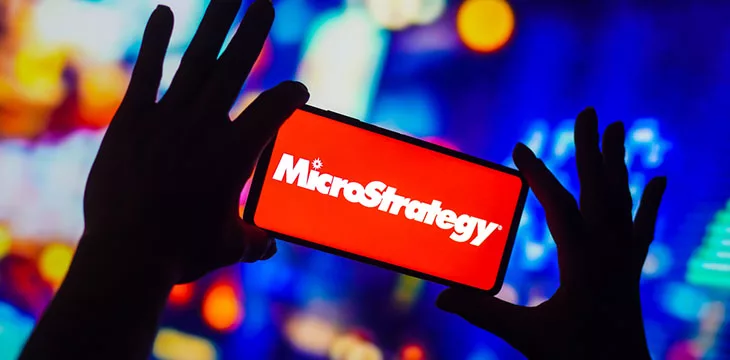|
Getting your Trinity Audio player ready...
|
For the four months they have existed so far, Ordinals have caused division and some dismay in the BTC camp, dividing opinions on what should be done about the massive number of transactions they have generated and the network congestion that has followed.
While BTC Core developers like Luke Dashjr have suggested dealing with them as spam, some big names, including digital currency exchange Binance, have shown support for non-fungible tokens (NFTs), leading many to wonder what will happen next.
Now, MicroStrategy (NASDAQ: MSTR) Chairman and BTC maximalist Michael Saylor has expressed support for Ordinals, saying, “we crossed this chasm from a bearish scenario into a bullish scenario” and that he’d be ecstatic about Ordinals if he was a miner. On a recent episode of the PBD Podcast, Saylor expressed support for the idea of data on Bitcoin generally, suggesting that a last will and testament would be a good use-case for an inscription. He also said that, in the long term, there would be many applications on the Bitcoin base layer.
Executive Chairman of MicroStrategy, @saylor, on the impact of Ordinals on Bitcoin mining and the power of inscriptions.
“What happened with Ordinals and NFTs is we crossed this chasm from what was a bearish scenario to a bullish scenario. If I was a miner I would be ecstatic.” pic.twitter.com/UDIGN5C08I
— Leonidas 🧡 $DOG (@LeonidasNFT) May 9, 2023
However, Saylor failed to express that the BTC base layer is incapable of hosting the many applications he envisages. In its current state, it can’t even handle a relatively small wave of NFT inscriptions without fees skyrocketing and the mempool jamming up, and much of the original functionality that would have allowed these applications has been stripped out by BTC Core developers.
Is the stage set for another BTC split?
For those who don’t know, there have been many disagreements in the history of Bitcoin. The most serious of these was over how to scale the blockchain. This disagreement was so severe that the Bitcoin network split into BTC and Bitcoin Cash before the Bitcoin Cash camp eventually split again, leading to the ticker BSV representing the original Bitcoin protocol.
Those who weren’t there would find it difficult to imagine how nasty this disagreement became. Threats, censorship, gaslighting, broken promises, and reputational attacks were all part of the Bitcoin civil war. BTC Core convinced the masses that small blocks with limited transaction throughput with second-layer scaling solutions such as the Lightning Network were the way to go, and that’s the way it has been since.
However, since then, little progress has been made on BTC scaling solutions, and users have been reluctant to adopt the convoluted Lighting Network or to use side chains like Liquid. This has set the stage for a second civil war as BTC Core developers threaten to shut down Ordinals, which is the best thing to happen to BTC in years.
Whether Core developers like it or not, humanity’s innate desire to innovate, invent, and build cool things won’t just go away by diktat. Ordinals, followed by BRC-20 tokens, show that there’s a huge appetite for base-layer Bitcoin transactions and that the HODL mentality is on the way out.
Satoshi designed Bitcoin for Ordinals and so much more
Of course, Satoshi Nakamoto foresaw all of this and designed Bitcoin to enable and facilitate various transaction types. He wasn’t wedded to the ‘decentralization‘ narrative as it is today, and he expressed the view that, as Bitcoin scaled, nodes would end up in data centers. Satoshi released Bitcoin with many Opcodes to facilitate data transfers and all kinds of transactions. However, you won’t hear that from the ‘digital gold’ camp anytime soon, as they’d rather you never know and the rest of us forget it.

Will BTC Core strike at the heart of innovation and entrepreneurship once again? Will the BTC chain split if they do? If so, where will those who support Ordinals and other tokens go? What will happen to Core Coin if big players like Changpeng Zhao and Saylor support the chain that allows for things like Ordinals? We already know miners will follow profits. Saylor pointed out that they’re making money hand over fist via transaction fees, thanks to the current flurry of on-chain activity.
I don’t have the answers to any of these questions, but I am watching with great interest as the inevitable consequences of small-block fanaticism and attempting to dictate what Bitcoin can and can’t be used for come to a head. While I don’t know what will happen to BTC or any further forks of the chain, I do know that unbounded Bitcoin with uncapped blocks and all of the original functionality, including the ability to mint NFTs and tokens for nano-payments, is alive and well on BSV. Satoshi and others saved Bitcoin, and it’s there to be used as you please within the confines of the law.
Who knows, maybe even Saylor, CZ, and others will see the light and come back to the original Bitcoin. I won’t hold out hope for that, but many unpredictable things have happened in the long and winding course of Bitcoin history, and nothing can be ruled out. Either way, those who want to build without restrictions can do so on Bitcoin SV today!
Watch: Ordinals on BSV! Luke Rohenaz explains their Utility and Value on the CoinGeek Weekly Livestream

 12-18-2025
12-18-2025 




